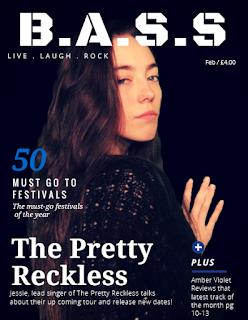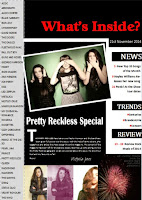 When looking back over my preliminary task, I am able to see
some big advances in the way I have both structured and design my magazines
from colour to content. Starting with my front cover page, from making my first
front cover to my last I feel that I have learnt a lot about imagery. My images
in my preliminary task are very basic and boring, they have not been edited and
have been taken at a simple and standard angle. The font of the magazine is
quite bold and blocked and the overall colour scheme for the magazine is large,
there are lost of different colours shown on my preliminary task and this makes
it difficult for the reader to focus on one particular thing. However, when
looking at my final product we can clearly see that I have progress and learned
new skills that I was able to apply to my music magazine. There is a big
difference between my preliminary task and my final product, the style of the
imagery is very different. The images that I took for my final product were
taken in a very professional way as I used an over the shoulder shot in order
to capture the attention of the audience. I really liked the overall outcome of
my magazine and the professional look of it. I think something key that I have learnt in the progression of my magazine would be about how to create a magazine cover professionally and with the appropriate conventions featured. When making my final product I thought a lot about the conventions that would be used in a music magazine and tried hard to follow and use these conventions, I like this meant that my magazine was able to look professional and look as though it should be on the shelf's. I feel that overall my skills in editing have progressed massively since my preliminary task as I did not use and editing techniques for the photos that I took for my school magazine, however when I was adding images to my magazine I used simple air-brushing and Photoshop techniques which allowed me to enhance the model and change her appearance if needed. I also used a range of filters on the images I took which I had not done before and this meant that my images were given a whole new look that would fit into my magazine.
When looking back over my preliminary task, I am able to see
some big advances in the way I have both structured and design my magazines
from colour to content. Starting with my front cover page, from making my first
front cover to my last I feel that I have learnt a lot about imagery. My images
in my preliminary task are very basic and boring, they have not been edited and
have been taken at a simple and standard angle. The font of the magazine is
quite bold and blocked and the overall colour scheme for the magazine is large,
there are lost of different colours shown on my preliminary task and this makes
it difficult for the reader to focus on one particular thing. However, when
looking at my final product we can clearly see that I have progress and learned
new skills that I was able to apply to my music magazine. There is a big
difference between my preliminary task and my final product, the style of the
imagery is very different. The images that I took for my final product were
taken in a very professional way as I used an over the shoulder shot in order
to capture the attention of the audience. I really liked the overall outcome of
my magazine and the professional look of it. I think something key that I have learnt in the progression of my magazine would be about how to create a magazine cover professionally and with the appropriate conventions featured. When making my final product I thought a lot about the conventions that would be used in a music magazine and tried hard to follow and use these conventions, I like this meant that my magazine was able to look professional and look as though it should be on the shelf's. I feel that overall my skills in editing have progressed massively since my preliminary task as I did not use and editing techniques for the photos that I took for my school magazine, however when I was adding images to my magazine I used simple air-brushing and Photoshop techniques which allowed me to enhance the model and change her appearance if needed. I also used a range of filters on the images I took which I had not done before and this meant that my images were given a whole new look that would fit into my magazine.  Looking at my contents page for my final product and I can see that progress has been made with the overall content and style from my preliminary task. There is a big difference in the type of fonts and texts used in the final product and I think that this had a big impact on the overall outcome of the page. The contents for my preliminary task was very empty and basic with minimal text, this is massively different form my final product which is filled with text but organised text with columns and bullet points. I learnt that to make my contents page more appealing I had to include a range of colours that would compliment each other such as red and green, which i have used in my final task contents page. In my preliminary task I had a very small target audience being school children, this I think was more difficult than making my final magazine attract a bigger selected audience. For my preliminary piece i found it difficult to accommodate my magazine to such a small target audience due to the fact I could not alternate and be as free with my design, content and layout.
Looking at my contents page for my final product and I can see that progress has been made with the overall content and style from my preliminary task. There is a big difference in the type of fonts and texts used in the final product and I think that this had a big impact on the overall outcome of the page. The contents for my preliminary task was very empty and basic with minimal text, this is massively different form my final product which is filled with text but organised text with columns and bullet points. I learnt that to make my contents page more appealing I had to include a range of colours that would compliment each other such as red and green, which i have used in my final task contents page. In my preliminary task I had a very small target audience being school children, this I think was more difficult than making my final magazine attract a bigger selected audience. For my preliminary piece i found it difficult to accommodate my magazine to such a small target audience due to the fact I could not alternate and be as free with my design, content and layout.
We did not make a double page spread for our preliminary task so having to create a double page spread for the first time taught my how to present large amounts of text in a way that was user friendly but also appealing to the audience and conventional at the same time. For the images that I used on my double page spread I used some quick editing and airbrushing to fix and blemishes and the makeup of the models and used the same filter over the top of both images. I think a key skill I learnt when making my double page spread was how to make a good layout of the page and why this is important to the overall look of the magazine. Having the text laid out in columns meant that the text was easy to view and the text was moveable and I was able to play more with the layout of the page.
Overall I think that I have learnt a lot about what and how to make a good magazine. My preliminary task was quite basic and cluttered, that meant that when first looking at it the audience were able to tell that I wasn't very experienced in making a magazine that was conventional and appealing to them. However when looking at my final product we can see that I have learnt from the mistakes I made on my preliminary tasks and took new skills that I have learnt and applied them in our to make a professional and conventional rock music magazine.















